|
Lipstick reds
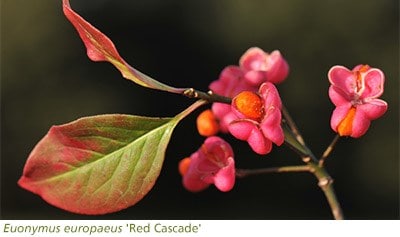
Bright red-pink is a touch-paper colour that glows in good light. There are certain shrubs and trees display this sparkling shade, which was good enough for Marilyn Monroe’s lips and toes. The earliest of all to colour up are the spindle trees, deciduous forms of euonymus that also bear spindle berries in day-glow orange and vivid pink. The fiery foliage always arrives by September and lingers for four weeks before the leaves drop. The strange winged fruits, suspended on straight stems, are loved by birds and often result in savage battles between rival robins desperate to keep them to themselves. Not surprisingly they disappear quickly. Good garden forms include ‘Red Cascade’, a small tree that’s easy, tolerant and smothered in spindles. The more shrub-like E. alatus bears lots of fruit and develops corky wings on the grey-brown bark, highly attractive in winter light.
More reds and pinks
If you like autumn foliage and red berries Cotoneaster ‘Hybridus Pendulus’ is a small tree topped by lots of weeping branches studded with red berries and small leathery evergreen leaves that redden late in the year. Or you could add a sorbus and ‘Eastern Promise’, a small tree with finely divided grey-green leaves, will give you pink berries and foliage that colours to orange in autumn. An AGM variety, ‘Eastern Promise’ is easier to grow than many and makes a perfect foil for pink hellebores because the berries persist over winter and into spring.
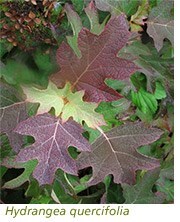 Small gardens can also get a blast of red using the oak-leaved hydrangea, H. quercifolia ‘Snow Queen’, in a container or tumbling over a low wall. The conical white flowers fade to pink against a chorus of red foliage, flecked in pink and coral, or you could use the new charteuse-green form ‘Little Honey’: it will still colour up in autumn and is even more-compact. The compact Bergenia ‘Overture’ is also perfect in a small space, with foot-high crimson leaves and lots of stems of bright-pink flower. Like all fleshy-stemmed bergenias it needs good drainage. Small gardens can also get a blast of red using the oak-leaved hydrangea, H. quercifolia ‘Snow Queen’, in a container or tumbling over a low wall. The conical white flowers fade to pink against a chorus of red foliage, flecked in pink and coral, or you could use the new charteuse-green form ‘Little Honey’: it will still colour up in autumn and is even more-compact. The compact Bergenia ‘Overture’ is also perfect in a small space, with foot-high crimson leaves and lots of stems of bright-pink flower. Like all fleshy-stemmed bergenias it needs good drainage.
Those same hints of pink develop on the burgundy leaves of Cotinus coggygria ‘Royal Purple’, although it’s larger and rangier. Cut back hard every year, only once established, it will develop larger lollipops at the expense of flower. Cotinus, commonly called smoke bushes due to their frothy flowers, come into leaf late and also lose their leaves late. This makes them useful additions to a prairie border - used with silver-awned 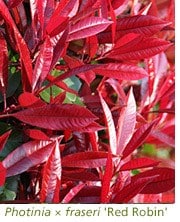 miscanthus. Or you could add warm-red glints with the evergreen shrub Photinia x fraseri ‘Red Robin’ or the new ‘Pink Marble’. Both have AGM awards and both produce red-tinted young growth that persists through winter. ‘Red Robin’ is a rich green and ‘Pink Marble’ a muted grey-green with cream. Both can be grown as specimens, or fused into a hedge. Cut both back in summer to promote young growth and underplant with spring-flowering blue muscari, to make the red tips seem even bolder. miscanthus. Or you could add warm-red glints with the evergreen shrub Photinia x fraseri ‘Red Robin’ or the new ‘Pink Marble’. Both have AGM awards and both produce red-tinted young growth that persists through winter. ‘Red Robin’ is a rich green and ‘Pink Marble’ a muted grey-green with cream. Both can be grown as specimens, or fused into a hedge. Cut both back in summer to promote young growth and underplant with spring-flowering blue muscari, to make the red tips seem even bolder.
Honey and mustard
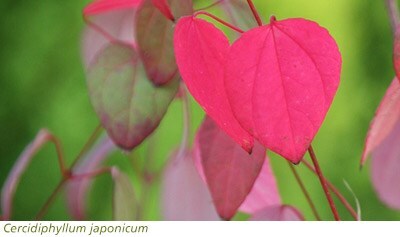
The Katsura tree, Cercidiphyllum japonicum, forms a much larger tree so this isn’t for a small garden. The heart-shaped leaves of this Japanese tree, which emerge a rich-claret, are very prone to frost damage, so a sheltered position away from frost pockets is ideal. By the beginning of September the leaves of mature trees exude a burnt-toffee aroma, before the foliage turns to shades of honey and butterscotch.
 Japanese acers, named forms of Acer palmatum, also suffer from frost damage in spring, unless sited carefully. However they are slow-growing so make excellent container plants grown in rugged frost-proof pots. 'Sango-kaku' offers something for every season, with pink-red shoots and branches in winter, pink-green maple-like leaves in spring and mustard-yellow leaves in autumn. Others are more finely divided and 'Inaba-shidare' has finely-cut burgundy leaves in autumn. Acers are expensive due to their slow growth habit, but this is one tree that should be bought when it’s a few years old so that it’s developed form and shape. Although hardy, be prepared to fleece at the leafing-up stage. Japanese acers, named forms of Acer palmatum, also suffer from frost damage in spring, unless sited carefully. However they are slow-growing so make excellent container plants grown in rugged frost-proof pots. 'Sango-kaku' offers something for every season, with pink-red shoots and branches in winter, pink-green maple-like leaves in spring and mustard-yellow leaves in autumn. Others are more finely divided and 'Inaba-shidare' has finely-cut burgundy leaves in autumn. Acers are expensive due to their slow growth habit, but this is one tree that should be bought when it’s a few years old so that it’s developed form and shape. Although hardy, be prepared to fleece at the leafing-up stage.
Golden highlights
A glint of gold is always welcome, but when it comes to foliage most golds have retreated into green. A few grass-like plants hold the baton and they include Bowles’ golden grass - Milium effusum ‘Aureum’. The pale foliage keeps it colour in winter and in late spring finely beaded awns, also in pale-gold, follow. It is a self-seeder, but seedlings can be removed easily. It flowers in dank places too, and the pale-gold foliage looks sensational against bare soil late in the year.
Light and Shade
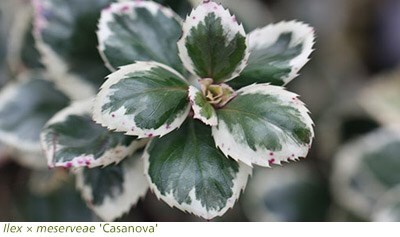
Variegated plants offer relief in shade, because they form patterns that look as though the sun is shining. Zebra grass, Miscanthus sinensis ‘Zebrinus’, was a Gertrude Jekyll favourite although she knew this green-blades grass with the golden horizontal bands as Eulalia japonica. The finer-tined ‘Morning Light’ is also Japanese in origin and they’ve appreciated its narrow grey-green leaves, vertically margined in white for centuries. It can look almost ghostly and it’s the perfect foil among vibrant flowers that might include purple asters. The same combination of white and sage-green, combining to give a steely gleam, occurs in some heucheras, including ‘Green Spice’. Or you could use the small American holly ‘Ilex x meserveae 'Casanova'. This recent holly is male, so there are no berries, but it will provide lots of pollen to cross with other female hollies, so its presence in your garden will produce more berry. The blue hollies, named for their blue-flushed foliage, are very hardy and ‘Casanova’ (a German variety launched in 2006) has round, not very prickly green leaves frosted in white edging. Eventually ‘Casanova’ will produce a dome, over a metre high.
Rich winter warmers in green
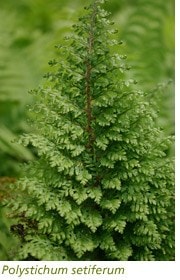 Green foliage begins to glow now, lifting the spirits on the first really cold mornings. The essential shrub, whether in a container or garden, is sarcococca because it will also provide winter fragrance. S. confusa is the most elegant with pendent clusters of ivory stamens supported by high-gloss green leaves. It avoids the metallic glints of other sarcococca foliage. Some hardy ferns also persist through winter and they include the orange-bristled forms of Polystichum setiferum, the soft-shield fern. ‘Herrenhausen’ has neatly arranged fronds that persist well in winter, with silk crocheted buds in April. The fussier, almost mossy Plumosomultilobum Group has 3D leaves, each one a miniature fir tree. Or, if you have somewhere dank and wet, opt for a ‘scolly’ or hart’s tongue fern - Asplenium scolopendrium. The linear leaves grow in the darkest place and there’s a frilly-topped from called ‘Crispum Cristalum Group’. Green foliage begins to glow now, lifting the spirits on the first really cold mornings. The essential shrub, whether in a container or garden, is sarcococca because it will also provide winter fragrance. S. confusa is the most elegant with pendent clusters of ivory stamens supported by high-gloss green leaves. It avoids the metallic glints of other sarcococca foliage. Some hardy ferns also persist through winter and they include the orange-bristled forms of Polystichum setiferum, the soft-shield fern. ‘Herrenhausen’ has neatly arranged fronds that persist well in winter, with silk crocheted buds in April. The fussier, almost mossy Plumosomultilobum Group has 3D leaves, each one a miniature fir tree. Or, if you have somewhere dank and wet, opt for a ‘scolly’ or hart’s tongue fern - Asplenium scolopendrium. The linear leaves grow in the darkest place and there’s a frilly-topped from called ‘Crispum Cristalum Group’.
Shiny periwinkles can also be used in wilder areas. The shorter Vinca minor comes in several forms, but the runners form a network of roots so this needs careful placing. V. minor f. alba 'Gertrude Jekyll’ is a pure-white single. ‘La Grave’ a lavender-blue and ‘Atropurpurea’ a dusky damson. The taller V. major also produces runners on long stems and is excellent against a wall. The star is the early-flowering V. difformis, with more whirligig flowers in light-blue.
Rosettes
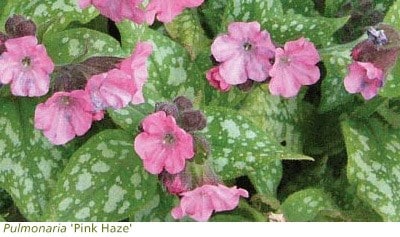
Rosettes shine against the bare soil, whether it’s verbascums, pulmonarias, or primroses. Given a tidy now they will make this time of year look fresher. Pulmonarias will have plenty of time to settle in if planted now, and the apple-green verdigris foliage of ‘Diana Clare’ is topped with violet-purple flowers in spring. Remove the seedheads, to avoid unwanted seedlings, but don’t shear this one back as you would the others in spring. A slight tidy suits it far better. ‘Pink Haze’ lives up to its name and the heavily spotted oval leaves are a real winter feature. The rosettes shelter insects and the early flowers satisfy the bumblebee, for like all members of the borage family, the nectar is quickly replenished.
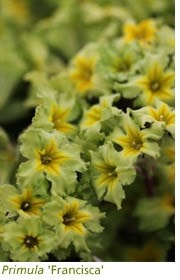 Primroses, lovers of cool shady places, also forms good rosettes and ‘Fransisca’ has unusual greenish ruffled flowers. Spotted on a traffic island in Surrey in British Columbia by a Canadian gardener called Francisca Darts, it’s probably a woodland primrose that’s hybridised with a showy bedding primula. 'Francisca’ flowers far longer than most and sets off the blues that might include the deciduous pulmonaria ‘Blue Ensign’. The purple-tinted new shoots that arrive in March are almost as good as the gentian-blue flowers. But for now foliage is what matters - so learn to love it as much as your flowers. Primroses, lovers of cool shady places, also forms good rosettes and ‘Fransisca’ has unusual greenish ruffled flowers. Spotted on a traffic island in Surrey in British Columbia by a Canadian gardener called Francisca Darts, it’s probably a woodland primrose that’s hybridised with a showy bedding primula. 'Francisca’ flowers far longer than most and sets off the blues that might include the deciduous pulmonaria ‘Blue Ensign’. The purple-tinted new shoots that arrive in March are almost as good as the gentian-blue flowers. But for now foliage is what matters - so learn to love it as much as your flowers.
|
Five things to do
 |
Make a winter container using foliage plants
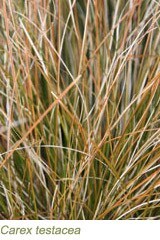
Too many containers find themselves stripped of plants in the autumn and placed into a shed. Plant one up and place it somewhere strategic, so that it welcomes you back on a grim day. Choose a theme such as silver and black, or rich-green and white, or gold. Start by choosing a feature plant that has good winter presence, like the swirling fox-red Carex testacea and then add some partners. Blue Anemone blanda will show off the russet tones of the grass in spring. Add a warmly toned heuchera, like ‘Marmalade’, to marry in colour but contrast in form. Drift in some dark highlights such as Ophiopogon planiscapus ‘Nigrescens’ and add a small potful of colourful pansies. As they fade replace them with spring bulbs.
|
 |
Weed out surplus seedlings
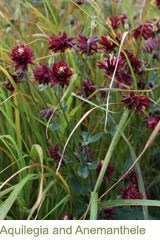
Get weeding, for seeds from astrantias and aquilegias will be germinating at far too great a rate. At this stage a sharp tug, or a trowel will work. Cut back self seeders (such as aconitums) to prevent unwanted seeds and, if the seeds are almost ripe, consign them to a green bin rather than the compost heap.
|
 |
Continue planting bulbs

At the end of the month temperatures will fall sharply making it perfect for planting tulips. While you wait, tidy any areas where bulbs will flower now, before they emerge. If you are not sure what to plant, then select a mixture like the Raspberry Ripple Collection in pink, purple, burgundy and white. Never plant in straight lines, do it randomly, and aim to plant at least twice the depth of the bulb.
|
 |
Turn over fallow areas of the garden
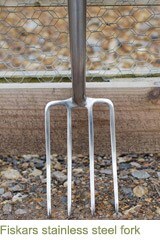
Winter provides freeze and thaw normally, so turn over any fallow soil with a fork and leave the weather to break it down. This is especially useful on heavier soils. It also provides relaxation, so enjoy gardening vicariously for a short while.
|
 |
Last mow and tidy of the year - perhaps!

Mow your lawn towards the end of the month, so that it stays tidy over winter. Move garden furniture etc indoors if you can. In milder areas box can be clipped, lightly, to tidy up topiary. Lightly is the key word though! |
|
|
Essential Kit for October

Traditional flexo lawn / leaf rake stainless steel
£24.99 £22.99

Lightweight shears
from £27.99
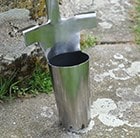
Traditional long handled bulb planter
£49.99 £29.99

De Wit Lawn edger wooden handle
£44.99

Organic lawn feed and improver
£7.99
|
|



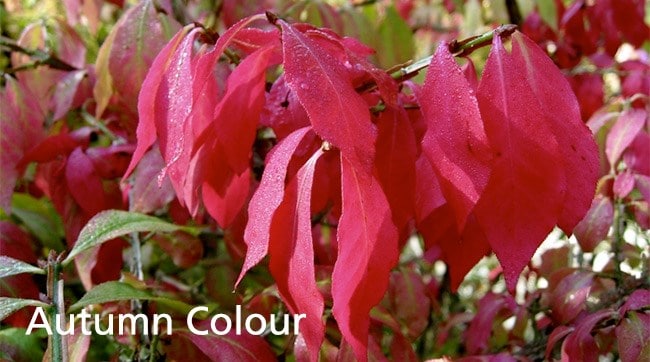


 miscanthus
miscanthus















